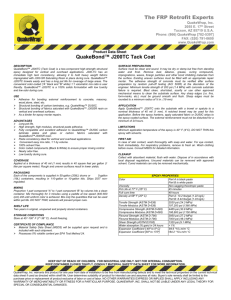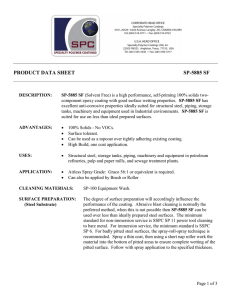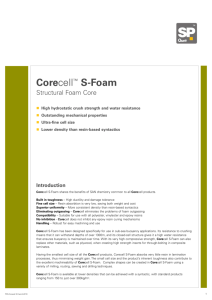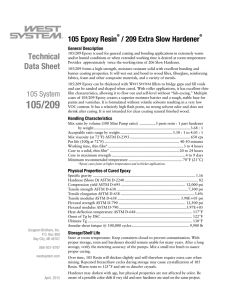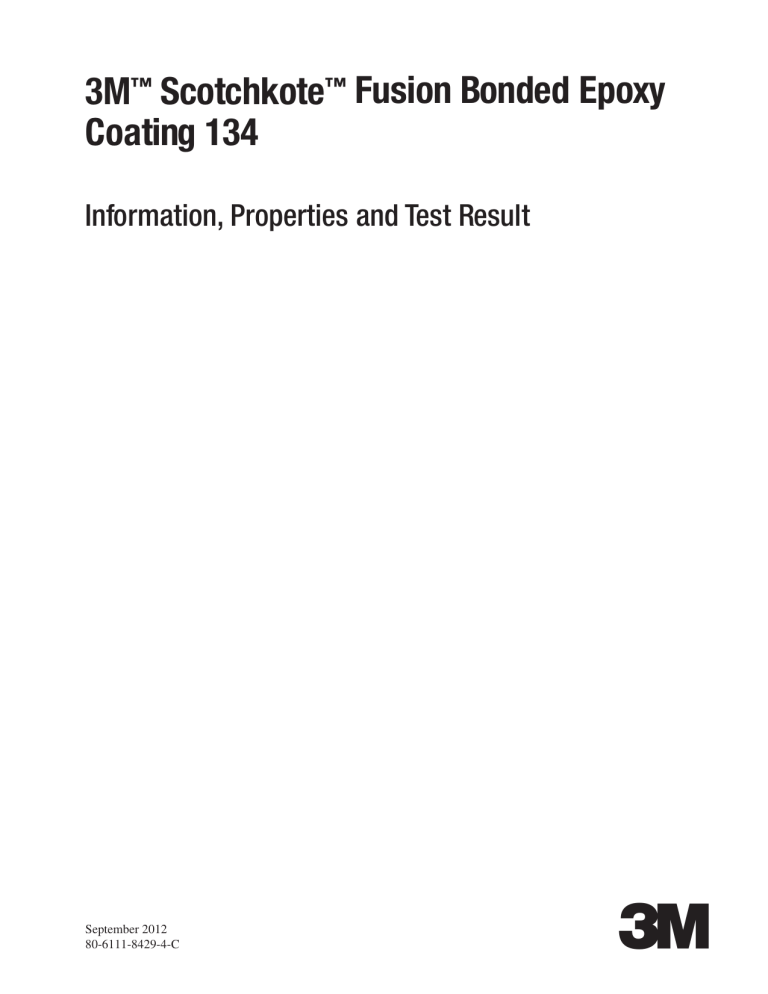
3M™ Scotchkote™ Fusion Bonded Epoxy
Coating 134
Information, Properties and Test Result
September 2012
80-6111-8429-4-C
3
Table of Contents
PAGE
1 - Introduction. . . . . . . . . . . . . . . . . . . . . . . . . . . . . . . . . . . . . . . . . . . . . . . . . . . . . . . . . . . . . . . . . . . . . . . . . . . . . . . 1
2 - Description . . . . . . . . . . . . . . . . . . . . . . . . . . . . . . . . . . . . . . . . . . . . . . . . . . . . . . . . . . . . . . . . . . . . . . . . . . . . . . . 1
3 - History. . . . . . . . . . . . . . . . . . . . . . . . . . . . . . . . . . . . . . . . . . . . . . . . . . . . . . . . . . . . . . . . . . . . . . . . . . . . . . . . . . . 1
4 - Manufacturing. . . . . . . . . . . . . . . . . . . . . . . . . . . . . . . . . . . . . . . . . . . . . . . . . . . . . . . . . . . . . . . . . . . . . . . . . . . . . 1
5 - Process and quality Control. . . . . . . . . . . . . . . . . . . . . . . . . . . . . . . . . . . . . . . . . . . . . . . . . . . . . . . . . . . . . . . . . . 2
6 - Packaging, Storage and Shipping . . . . . . . . . . . . . . . . . . . . . . . . . . . . . . . . . . . . . . . . . . . . . . . . . . . . . . . . . . . . . . 2
7 - Properties of the Powder. . . . . . . . . . . . . . . . . . . . . . . . . . . . . . . . . . . . . . . . . . . . . . . . . . . . . . . . . . . . . . . . . . . . . 3
8 - Properties of the Coating. . . . . . . . . . . . . . . . . . . . . . . . . . . . . . . . . . . . . . . . . . . . . . . . . . . . . . . . . . . . . . . . . . . . . 3
8.1
Hardness . . . . . . . . . . . . . . . . . . . . . . . . . . . . . . . . . . . . . . . . . . . . . . . . . . . . . . . . . . . . . . . . . . . . . . . . . 3
8.2
Tensile Strength. . . . . . . . . . . . . . . . . . . . . . . . . . . . . . . . . . . . . . . . . . . . . . . . . . . . . . . . . . . . . . . . . . . . 3
8.3
Elongation. . . . . . . . . . . . . . . . . . . . . . . . . . . . . . . . . . . . . . . . . . . . . . . . . . . . . . . . . . . . . . . . . . . . . . . . 5
8.4
Impact Resistance. . . . . . . . . . . . . . . . . . . . . . . . . . . . . . . . . . . . . . . . . . . . . . . . . . . . . . . . . . . . . . . . . . 5
8.5
Adhesive Strength. . . . . . . . . . . . . . . . . . . . . . . . . . . . . . . . . . . . . . . . . . . . . . . . . . . . . . . . . . . . . . . . . . 5
8.6
Penetration Resistance . . . . . . . . . . . . . . . . . . . . . . . . . . . . . . . . . . . . . . . . . . . . . . . . . . . . . . . . . . . . . . 5
8.7
Bendability . . . . . . . . . . . . . . . . . . . . . . . . . . . . . . . . . . . . . . . . . . . . . . . . . . . . . . . . . . . . . . . . . . . . . . . 5
8.8
Thermal – Mechanical . . . . . . . . . . . . . . . . . . . . . . . . . . . . . . . . . . . . . . . . . . . . . . . . . . . . . . . . . . . . . . 5
8.9
Volume Resistivity . . . . . . . . . . . . . . . . . . . . . . . . . . . . . . . . . . . . . . . . . . . . . . . . . . . . . . . . . . . . . . . . . 6
8.10
Electric strength. . . . . . . . . . . . . . . . . . . . . . . . . . . . . . . . . . . . . . . . . . . . . . . . . . . . . . . . . . . . . . . . . . . 6
8.11
Weathering Resistance . . . . . . . . . . . . . . . . . . . . . . . . . . . . . . . . . . . . . . . . . . . . . . . . . . . . . . . . . . . . . . 6
8.12
Cathodic Disbondment Resistance. . . . . . . . . . . . . . . . . . . . . . . . . . . . . . . . . . . . . . . . . . . . . . . . . . . . . 6
8.13
Moisture Resistance . . . . . . . . . . . . . . . . . . . . . . . . . . . . . . . . . . . . . . . . . . . . . . . . . . . . . . . . . . . . . . . . 6
8.14
Autoclave Testing. . . . . . . . . . . . . . . . . . . . . . . . . . . . . . . . . . . . . . . . . . . . . . . . . . . . . . . . . . . . . . . . . . 7
8.15
Taste and Odor Production Potential . . . . . . . . . . . . . . . . . . . . . . . . . . . . . . . . . . . . . . . . . . . . . . . . . . . 10
8.16
VOC Production Potential. . . . . . . . . . . . . . . . . . . . . . . . . . . . . . . . . . . . . . . . . . . . . . . . . . . . . . . . . . . . 10
3M ™ Scotchkote ™ Fusion Bonded Epoxy Coating 134
1 - Introduction
The cost of the coating is only a small fraction of the cost of a tubing string, yet the coating is the major means of
assuring extended operation by preventing deterioration and service disruption due to corrosion loss. 3M™ Scotchkote™
Fusion Bonded Epoxy Coatings represent a significant improvement in internal coating technology for the oil, gas and
water industries.
2 - Description
Scotchkote fusion bonded epoxy coating 134 is a one - part, heat curable, thermosetting epoxy coating designed for
corrosion protection of metal. The epoxy is applied to preheated steel as a dry powder which melts and cures to a
uniform, coating thickness. This bonding process provides excellent adhesion and coverage on applications such as
valves, pumps, pipe drains, hydrants and porous castings. Scotchkote 134 FBEC assistant to waste water, corrosive
soils, hydrocarbons, harsh chemicals and sea water. Powder properties allow easy manual or automatic application by
electrostatic or air - spray equipment. When applied over a suitable primer, it is appropriate for operation at moderate
temperatures and pressures in the presence of H2O, CO and CH , crude oil and brine.
2
4
Scotchkote 134 FBEC consists of a blend of epoxy resin and curing agent additives, pigments, catalysts, leveling and
flow control agents. Possible combinations of raw materials are extensive; hence careful selection has been made by
3M so that the resultant coating will serve in the environment encountered. Scotchkote 134 FBEC has been designed
to allow trouble - free, consistent production application at the coating plant. Selection of the chemical elements for the
fusion bonded epoxy coating is very important. The molecular structure of the epoxy resin, the type and reactivity of
the hardener, catalyst and additives all play an important role in the ultimate coatability and performance of the fusion
bonded epoxy.
3M Company maintains a divisional laboratory group dedicated to the research and development of fusion bonded
epoxy coating. The group’s personnel have many years of experience in the formulation and evaluation of epoxy
coatings. This effort is assisted by 3M staff laboratories with broad - based expertise in scientific disciplines applicable
to coating and surface technology. In addition, 3M synthesizes and manufactures specialized epoxy resins, hardeners,
catalysts and additives used to formulate Scotchkote FBE coatings to meet unusual performance and operational
requirements.
3 - History
Scotchkote 134 FBEC has been used extensively in the oil and gas industry to coat the exterior and interior of line pipe.
Over 40,000 miles (65,000 km) of Scotchkote coated pipe have been installed thoughout the world. This technology has
been expanded through 3M research to develop chemically stable, high temperature/pressure resistant internal linings
for use in drill pipe, primary and secondary recovery tubing, and pipe for oil, gas and water transportation. Coating
properties have been proven by rigorous 3M autoclave testing, and the results verified by independent laboratory and
customer investigation.
4 - Manufacturing
All Scotchkote fusion bonded epoxy coating powders are made using the fusion blend process developed by 3M.
Ingredients are first pulverized, properly proportioned and homogeneously dry mixed. Next, the blended materials are
carefully and thoroughly mixed in the molten state using a continuous melt mixer. The fused blend is cooled and then
pulverized into the final powered form. Particle size distribution is carefully monitored to meet optimum application
standards required by the various coating plants. The fusion blend process assures that each particle of the coating
powder contains all active ingredients, thus eliminating changes in reactivity due to separation or stratification of
ingredients during transportation and application.
1
5 - Process and Quality Control
Process control is essential to the quality of the finished product. 3M maintains rigid incoming quality inspection of raw
materials, precise measurement and metering of critical components, controlled environmental conditions and processing
temperatures for the chemical constituents, and a discerning outgoing inspection of the finished coating powder to assure
uniformity of product application and performance. Among the quality control tests performed on 3M powder coatings
are: gel time, cure, flow, fluidization, particle distribution, adhesion, impact, appearance and moisture content.
6 - Packaging, Storage and Shipping
Scotchkote 134 FBEC is packaged in a heavy duty, polyethylene bag in a stout, easy open, fiberboard carton which is
clearly labeled with product number and manufacturing identification. This package protects the coating powder from
humidity and contamination during shipment and storage. The net weight is 65 U.S. lbs. (29.5 kilos). The sealed cartons
are palletized on wooden pallets with net weight of 1170 lbs. (530 kilos) and securely banded for shipment. The packaged
product must be shipped and stored at temperatures not exceeding 80˚F (27˚C).
2
7 - Properties of the Powder
3M ™ Scotchkote ™ Fusion Bonded Epoxy Coating 134
Property
Test Method
Value
Classification
ASTM D 1763
Type 1, Grade 2
Color
–
Forest Green
Gloss
Gardener 60˚ gloss meter,
350˚ (177˚C) application
temperature
34 average
Air Pycnometer
1.51
Coverage
Calculated from air
pycnometer specific gravity
of powder
125 ft2/lb/mil
0.66 m2/kg/mm
Gel time at 400˚F (204˚C)
Hot plate
120 sec average
Glass Plate
Pill Flow
3M glass slide
300˚F (149˚C)
12 mm diameter, 0,85
gram pill, 1 min horizontal,
15 min. at 63˚ angle
75 - 100 mm average flow
Moisture Content
at time of manufacture
Carl Fischer
<0.3%
Particle size
Alpine sieve analysis
>177 µm 1%
<44 µm 45 - 55%
Heat of Polymerization
Differential Scanning
Calorimeter
70 J/gm typical
Glass Transition
Temperature of
Cured Coating
Differential Scanning
Calorimeter
(midpoint)
107˚C (225˚F) typical
Specific Gravity
(Powder)
8 - Properties of the Coating
All tests have been conducted at 73˚F (23˚C) on unprimed surfaces unless otherwise noted.
8.1 Hardness
Property
Test Method
Test Results
Hardness
Barcol, ASTM D 2583
23
ASTM D 785
89
Rockwell M
55
Property
Test Method
Test Results
Tensile Strength
ASTM D 2370
7300 psi
free film
513 kg/cm2
8.2 Tensile Strength
3
100
% Transmittance
80
60
40
20
4000
3500
3000
2000
2500
Wavenumber (cm-1)
1500
1000
Sample: S/K 134 3B26-51 L09D2139
Size: 7.2000 mg
Method: S/K 134
Comment: EQUIL. 20˚C/MIN-70˚C, 20˚C/MIN-310˚C, 20˚C/MIN-160˚C, N2
2.5
-2.5
1.5
-3.5
107.00˚C
0.5
Heat Flow (mW)
500
-4.5
188.90˚Ç
-0.5
-5.5
-1.5
-6.5
-2.5
-4.5
-7.5
48.90˚C
-3.5
-8.5
158.97˚C
70.93 J/g
0
50
100
Heat Flow (mW)
0
150
200
Temperature (˚C)
250
-9.5
300
350
General V4.0D DuPont 2100
4
8.3 Elongation
Property
Test Method
Test Results
Elongation
ASTM D 2370
free film
4.2%
Property
Test Method
Test Results
Impact
Gardener, 5/8 in.
(16 mm) diameter tup,
0,125 in (3.2 mm) panel
8.4 Impact Resistance
160 in - lbs.
18,1 J
8.5 Adhesive Strength
Property
Test Method
Shear
ASTM D 1002, 10 mil
(254 µm glue line)
Test Results
4300 psi
302 kg/cm2
8.6 Penetration Resistance
Property
Test Method
Test Results
Penetration
ASTM G 17
- 40˚ to 240˚F
( - 40˚ to 116˚C)
0
Compression strength
ASTM D 695
12800 psi
900 kg/cm2
Property
Test Method
Test Results
Bend
3/8 in. (9,5 mm)
primed and unprimed
coupon mandrel bend
Pipe Dia.=30
Elongation (%)=1.7
Angle of Deflection
(˚/PDL) =1.9
Property
Test Method
Test Results
Thermal Conductivity
MIL - I - 16923E
7x10 - 4 cal/sec/cm2/C˚/cm
Thermal Shock
3M, 10 cycles
Unaffected by thermal
shock
8.7 Bendability
8.8 Thermal - Mechanical
- 100˚ to 300˚F
( - 70˚ to 150˚C)
5
8.9 Volume Resistivity
Property
Test Method
Volume Resistivity
ASTM D 257
Test Results
1.2 x 1015 ohm•cm
8.10 Electric Strength
Property
Test Method
Test Results
Electric Strength
ASTM D 149
1000 V/mil
40 kV/mm
Property
Test Method
Test Results
Weathering Resistance
Weatherometer
ASTM G 53, 5000 hrs.
Surface chalk
8.11 Weathering Resistance
Condensation test temp. 50˚C
Cycle time 4 hours UV/
Four hours condensation
Salt Fog
No blistering
MIL - E - 5272C
No blistering
No discoloration
No loss of adhesion
Property
Test Method
Test Results
Cathodic Disbondment
Resistance
30 day, 5 volt
5% NaCl, sand crock
230˚F (110˚C)
Disbondment radius
24 mmr average
4 day 3 volt
3% NaCl
71˚C (160˚F)
5 mmr average
Property
Test Method
Test Results
Water Immersion
ASTM D 570
free film, 30 day
10 mil (250 mm)
6,5 g/m 2 weight gain
8.12 Cathodic Disbondment Resistance
8.13 Moisture Resistance
6
Notes on Autoclave Testing
Notes: All tests conducted on coatings applied over 1 mil (25.4 µm) liquid phenol primer.
‘Pass’ means excellent adhesion, no blisters, no swelling in a phases, i.e.: aqueous, hydrocarbon or gas phase.
‘Fail’ means loss of adhesion, or blisters, or excessive swelling in any phases.
8.14 Autoclave Testing
Property
Test Method
Test Results
Pressure / Temperature
Duration
1500 psi (10.3 MPa)
120˚F (49˚C)
24 hours
Excellent adhesion, no
coating loss or blisters in
aqueous, hydrocarbon or gas
phase
Gas Phase
99.5%
0.5%
Liquid Phase
33.0% Kerosene
33.0% Toluene
34.0% Brine Solution
(5% NaCl)
Discharge
Discharge Rapid at
Test Temperature
CO2
H 2S
Autoclave Test #1
Property
Test Method
Test Results
Pressure/Temperature
Duration
5 psi (0.03 MPa)
68˚F (20˚C)
72 hours
Pass
Gas Phase
100%
Liquid Phase
Turks Island Sea Water
Discharge
Release pressure over 5 min.
@ test temperature
H2S
Autoclave Test #2
Property
Test Method
Test Results
Pressure/Temperature
Duration
60 psi (0.4 MPa)
150˚F (66˚C)
24 hours
Pass
Gas Phase
100%
CO2
Liquid Phase
5%
NaCl Brine
Discharge
Release pressure over 1/2 hour
period @ test temperature
7
Autoclave Test #3
Property
Test Method
Test Results
Pass
Pressure/Temperature
450 psi (3.1 MPa)
Duration
185˚F (85˚C)
24 hours
Gas Phase
15%
CO2
84.9% N2
0.1%
H2S
71˚C (160˚F)
Liquid Phase
Deionized Water Crude Oil
Discharge
Release pressure over 5 min.
@ test temperature
Autoclave Test #4
Property
Test Method
Test Results
Pressure/Temperature
2000 psi (13.8 MPa)
Pass
Duration
200˚F (93˚C)
16 hours
Gas Phase
5%
CO2
94.5% Methane
0.5% H2S
Liquid Phase
5%
Discharge
Cool for 4 hours then rapidly release pressure
NaCl Brine
Autoclave Test #5
Property
Test Method
Test Results
Pass
Pressure/Temperature
3300 psi (22.8 MPa)
Duration
200˚F (93˚C)
24 hours
Gas Phase
34%
(5%
33%
33%
Brine
NaCl)
Kerosene
Toluene
Liquid Phase
8%
86%
6%
CO2
Methane
H 2S
Discharge
Cool overnight to ambient release pressure
over 1/2 hr. period
Autoclave Test #6
Property
Test Method
Test Results
Pressure/Temperature
2500 psi (17.2 MPa)
Pass
Duration
200˚F (93˚C)
24 hours
Gas Phase
10%
90%
Liquid Phase
Wasia Water
Discharge
Release pressure over 1/2 hr. period
@ test temperature
CO2
N2
8
Autoclave Test #7
Property
Test Method
Test Results
Pressure/Temperature
1500 psi (10.3 MPa)
Pass
Duration
120˚F (49˚C)
48 hours
Gas Phase
95.5% CO2
0.5% H2S
Liquid Phase
34%
(5%
33%
33%
Discharge
Instant pressure release @ test temperature
Brine
NaCl)
Kerosene
Toluene
Autoclave Test #8
Property
Test Method
Test Results
Pressure/Temperature
35 psi (0.2 MPa)
Pass
Duration
200˚F (93˚C)
24 hours
Gas Phase
Air
Liquid Phase
15% HCI
Discharge
Force cool to ambient release
pressure over 5 min. period
Autoclave Test #9
Property
Test Method
Test Results
Pressure/Temperature
2200 psi (15.2 MPa)
Pass
Duration
150˚F (66˚C)
24 hours
Gas Phase
12%
80%
8%
CO2
Methane
H 2S
Liquid Phase
34%
(5%
33%
33%
Brine
NaCl)
Kerosene
Toluene
Discharge
Release pressure over 1/2 hr. period
@ test temperature
Autoclave Test #10
Property
Test Method
Test Results
Pressure/Temperature
4000 psi (27.5 MPa)
Pass
Duration
225˚F (107˚C)
24 hours
Gas Phase
100%
CO2
Liquid Phase
5%
NaCl Solution
saturated with H2S
Discharge
Cool to ambient release pressure over 45 sec.
9
Autoclave Test #11
Property
Test Method
Test Results
Pressure/Temperature
150 psi (1.0 MPa)
Pass
Duration
250˚F (121˚C)
24 hours
Gas Phase
25%
55%
10%
10%
C02
H2S
Methane
N2
Liquid Phase
28%
NaCl Solution
Discharge
Cool for 2 hours release pressure over 15 min.
Autoclave Test #12
Property
Test Method
Test Results
Slight swell
Pressure/Temperature
3000 psi (20.7 MPa)
Duration
300˚F (149˚C)
24 hours
Gas Phase
10%
90%
Trace
C02
Methane
H2S
Liquid Phase
34%
(5%
33%
33%
Brine
NaCl)
Kerosene
Toluene
Discharge
Cool to 104˚F (40˚C) release pressure over 1/2 hr.
8.15 Taste and Odor Production Potential
Property
Threshold Odor
Number (TON)
(Ton of 10 or less
is passing)
Test Method
20˚C
60˚C
Test Results
5 days
1
1
TON
10 days
1
1
Results: Pass
Type Odor: None
8.16 VOC Production Potential
Property
Test Method
Test Results
VOC Analysis
5 day soak cycle
Pass. Appears clean
and free of significant
VOC contamination
10
3M is a trademark of 3M Company.
Important Notice
All statements, technical information and recommendations related to 3M
Products are based on information believed to be reliable, but the accuracy
or completeness is not guaranteed. Before using the 3M Product, you must
evaluate it and determine if it is suitable for your intended application. Because
conditions of Product use are outside of our control and vary widely you assume
all risks and liability associated with such use. Any Product-related statements
not contained in current 3M publications, or any contrary statements contained
in your purchase order, shall have no force or effect unless expressly agreed to
in writing by an authorized officer of 3M.
Warranty; Limited Remedy; Limited Liability.
3M warrants that Product will conform to 3M published specifications upon
shipment. If Product is proven not to have met the specifications your exclusive
remedy and 3M's sole obligation will be, at 3M's option, to replace the Product
or to refund the purchase price of the Product. EXCEPT WHERE PROHIBITED BY
LAW, THIS WARRANTY IS MADE IN LIEU OF ALL OTHER WARRANTIES, EXPRESS
OR IMPLIED, INCLUDING, BUT NOT LIMITED TO, ANY IMPLIED WARRANTY OF
MERCHANTABILITY, FITNESS FOR A PARTICULAR PURPOSE OR THOSE ARISING
FROM A COURSE OF DEALING, CUSTOM OR USAGE OF TRADE. Buyer is an
expert in its field and is responsible for determining if Products are suitable for
a particular purpose or application. 3M has no obligation under this warranty
with respect to any Product that has failed due to inadequate or improper
storage, handling, surface preparation, application, or maintenance; failure
to follow Product instructions; or alteration or damage to the Product caused
by accident, neglect, or misuse. EXCEPT WHERE PROHIBITED BY LAW, IN NO
EVENT SHALL 3M BE LIABLE FOR ANY DIRECT, INDIRECT, SPECIAL, INCIDENTAL
OR CONSEQUENTIAL LOSS OR DAMAGES (INCLUDING LOST PROFITS) ARISING
FROM THIS PRODUCT, REGARDLESS OF THE LEGAL THEORY ASSERTED.
3
Infrastructure Protection Division
6801 River Place Blvd.
Austin, TX 78726-9000
http://www.3M.com/corrosion
Please recycle. Printed in USA.
© 3M 2012. All rights reserved.
80-6111-8429-4-C


